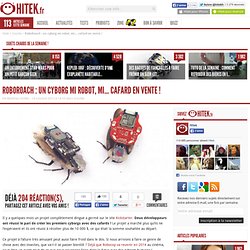

RoboRoach : un cyborg mi robot, mi… cafard en vente ! Vous aimez nos articles ?

Suivez nous sur facebook Vous aimez nos articles ? Suivez nous sur twitter Déjà 204 réaction(s),partagez cet article avec vos amis ! Il y a quelques mois un projet complètement dingue a germé sur le site Kickstarter. Ce projet à l’allure très amusant peut aussi faire froid dans le dos. Les cafards utilisent les antennes qu’ils ont sur la tête pour se déplacer, elles sont très sensibles aux odeurs et à ce qu’elles touchent. Le principe du RoboRoach est simple, c’est une fusion de neurosciences comportementales et d’ingénierie des neurones (oui j’ai dit simple). Pour recevoir cette puce, le cafard doit subir une intervention chirurgicale (pauvre petite bête), mais rassurez-vous, c’est sous anesthésie !
Et vous qu’en pensez-vous ? Voici le principe en vidéo : HyperNEAT User's Page. Www.nerogame.org. Computers: Artificial Intelligence: Machine Learning: Software. Neural Networks with Java. Neuroevolution of augmenting topologies. NeuroEvolution of Augmenting Topologies (NEAT) is a genetic algorithm for the generation of evolving artificial neural networks (a neuroevolution technique) developed by Ken Stanley in 2002 while at The University of Texas at Austin.

It alters both the weighting parameters and structures of networks, attempting to find a balance between the fitness of evolved solutions and their diversity. It is based on applying three key techniques: tracking genes with history markers to allow crossover among topologies, applying speciation (the evolution of species) to preserve innovations, and developing topologies incrementally from simple initial structures ("complexifying"). Performance[edit] On simple control tasks, the NEAT algorithm often arrives at effective networks more quickly than other contemporary neuro-evolutionary techniques and reinforcement learning methods.[1][2] Complexification[edit] Implementation[edit] Extensions to NEAT[edit] rtNEAT[edit] Phased Pruning[edit] HyperNEAT[edit] Network topology. A good example is a local area network (LAN): Any given node in the LAN has one or more physical links to other devices in the network; graphically mapping these links results in a geometric shape that can be used to describe the physical topology of the network.

Conversely, mapping the data flow between the components determines the logical topology of the network. Topology[edit] There are two basic categories of network topologies:[4] Physical topologiesLogical topologies The shape of the cabling layout used to link devices is called the physical topology of the network. The logical topology in contrast, is the way that the signals act on the network media, or the way that the data passes through the network from one device to the next without regard to the physical interconnection of the devices. Diagram of different network topologies.
The study of network topology recognizes eight basic topologies:[5] Point-to-pointBusStarRing or circularMeshTreeHybridDaisy chain Point-to-point[edit] NeuroEvolution of Augmenting Topologies. I created this page because of growing interest in the use and implementation of the NEAT method. I have been corresponding with an expanding group of users. Because the same points come up more than once, it makes sense to have a place where people can come and tap into the expanding knowledge we have about the software and the method itself. We also developed an extension to NEAT called HyperNEAT that can evolve neural networks with millions of connections and exploit geometric regularities in the task domain.
The HyperNEAT Page includes links to publications and a general explanation of the approach. New! Tutorial Available: Wesley Tansey has provided a helpful tutorial on setting up a Tic-Tac-Toe experiment in SharpNEAT 2. NEAT Software FAQ - Questions that mostly relate to coding issues or using the actual software. First, how closely does the package you want follow my (Ken's) original NEAT source code? Second, what is your favorite platform? Third, what language do you prefer?